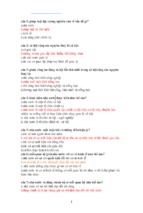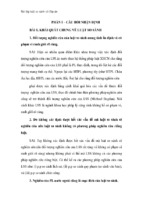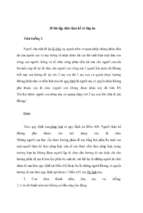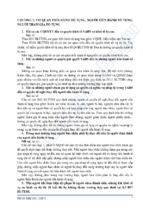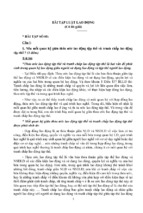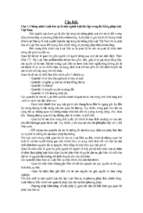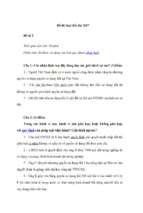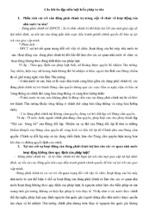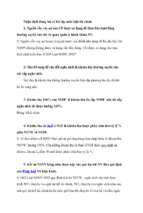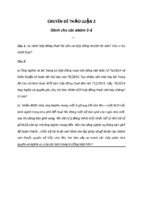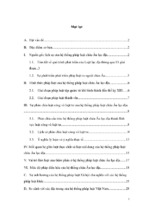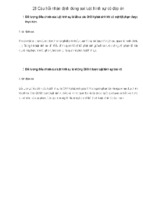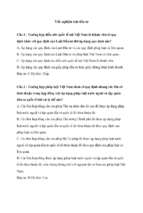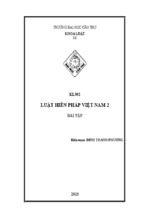HO CHI MINH CITY UNIVERSITY OF LAW
THE MANAGING BOARD OF ADVANCED PROGRAMS
----
TRAN MINH THAO
STUDENT ID: 1753801012182
ENVIRONMENTAL PROTECTION
RIGHT TOWARD FAIR AND
EQUITABLE TREATMENT AND
INDIRECT EXPROPRIATION
REGULATIONS IN EVIPA AND
RECOMMENDATIONS FOR VIETNAM
BACHELOR’S THESIS
ACADEMIC YEAR: 2017 - 2021
MAJOR: INTERNATIONAL LAW
HO CHI MINH CITY - 2021
Acknowledgement
I want to express my sincere thanks to Ms. Nguyen Thi Lan Huong from Ho Chi
Minh City University of Law for her guidance on outline of this essay. Thanks to her
I am able to visualize the purpose and method to research on this interesting topic.
Besides, I also extend my thanks to Mr. Ngo Hoang Kim Nguyen, my academic
advisor, who was always concerned and helpful to me during my four years at
university.
Last but not least, I would like to thank my family and all of my friends for their
spiritual support and encouragement as I strive towards my goal.
Commitment
I hereby declare that this thesis “Environmental Protection Right toward Fair and
Equitable Treatment and Indirect Expropriation regulations in EVIPA and
Recommendations for Vietnam” is wholly my own work, unless otherwise referenced
or acknowledged. I will bear complete responsibility for my commitment.
Tran Minh Thao
July 3rd, 2021
Table of Contents
PREAMBLE ..................................................................................................................................................... 1
1.
JUSTIFICATION OF THESIS:......................................................................................................... 1
2.
LITERATURE REVIEW ................................................................................................................. 4
2.1.
Materials in Vietnamese ....................................................................................................... 4
2.2.
Materials in foreign languages ............................................................................................ 5
3.
PURPOSE OF THESIS .................................................................................................................... 5
4.
RESEARCH DELIMITATION......................................................................................................... 6
5.
RESEARCH METHODOLOGIES .................................................................................................... 6
6.
STRUCTURE OF THESIS ............................................................................................................... 6
CHAPTER 1: OVERVIEW ON ENVIRONMENTAL PROTECTION RIGHT TOWARD FAIR
AND EQUITABLE TREATMENT AND INDIRECT EXPROPRIATION REGULATIONS IN
INTERNATIONAL INVESTMENT LAW ................................................................................................... 8
1.1.
OVERVIEW ON FAIR AND EQUITABLE TREATMENT STANDARD IN INTERNATIONAL
INVESTMENT LAW ....................................................................................................................................... 8
1.1.1.
The historical origin of Fair and Equitable Treatment standard ....................................... 8
1.1.2.
Definition and content of Fair and Equitable Treatment standard .................................. 10
1.1.3.
Requirements of Fair and Equitable Treatment ................................................................ 13
1.1.3.1.
The obligation of vigilance and protection ................................................................................13
1.1.3.2.
Due process including non-denial of justice ..............................................................................13
1.1.3.3.
Lack of arbitraness and non-discrimination .............................................................................15
1.1.3.4.
Transparency and stability of legal and business framework and the protection of
investors’ legitimate expectations ...................................................................................................................15
1.2.
OVERVIEW ON INDIRECT EXPROPRIATION IN INTERNATIONAL INVESTMENT LAW ............. 17
1.2.1.
Definition of indirect expropriation ................................................................................... 17
1.2.2.
Requirements for a lawful Indirect Expropriation ............................................................ 20
1.3.
1.2.2.1.
Public purpose .............................................................................................................................20
1.2.2.2.
Non-discrimination ......................................................................................................................22
1.2.2.3.
Due process of law .......................................................................................................................22
1.2.2.4.
Payment of compensation ...........................................................................................................24
1.2.2.5.
Additional requirements under IIAs..........................................................................................28
ENVIRONMENTAL PROTECTION RIGHT IN INTERNATIONAL INVESTMENT LAW ................... 28
1.3.1.
Conflict of interest between the foreign investors’ right and the Environmental
Protection right in International Investment Law ............................................................................... 28
1.3.2.
Police powers doctrine ........................................................................................................ 30
1.3.3.
Environmental Protection right in New Generation Internation Investment law ............ 34
SUB-CONCLUSION: ..................................................................................................................................... 39
CHAPTER 2: ENVIRONMENTAL PROTECTION RIGHT TOWARD FAIR AND EQUITABLE
TREATMENT AND INDIRECT EXPROPRIATION REGULATIONS IN EVIPA AND
RECOMMENDATIONS FOR VIETNAM ................................................................................................. 40
2.1.
ENVIRONMENTAL PROTECTION RIGHT TOWARD FAIR AND EQUITABLE TREATMENT AND
INDIRECT EXPROPRIATION REGULATIONS IN EVIPA .............................................................................. 40
2.1.1.
Preamble of EVIPA ............................................................................................................ 40
2.1.2.
Provisions affirming the State’s right to enact policies and implement measures for
environmental protection ..................................................................................................................... 41
2.1.3.
Provisions on Fair and Equitable Treatment .................................................................... 42
2.1.4.
Provisions on Indirect Expropriation ................................................................................ 44
2.1.5.
Evaluating Environmental Protection Right on Fair and Treatment and Indirect
Expropriation regulations in EVIPA ................................................................................................... 46
2.2.
RECOMMENDATIONS FOR VIETNAM ON THE APPLICATION THE FAIR AND EQUITABLE
TREATMENT AND INDIRECT EXPROPRIATION REGULATIONS IN EVIPA TOWARDS ENVIRONMENTAL
PROTECTION GOAL..................................................................................................................................... 46
2.2.1.
Maintaining the legal framework's stability and uniformity ............................................. 46
2.2.2.
Ensuring the suitability of environmental protection measures ....................................... 47
2.2.3.
Strengthening the capacity of the competent authorities .................................................. 47
SUB-CONCLUSION: ..................................................................................................................................... 48
CONCLUSION .............................................................................................................................................. 49
Lists of abbreviations
ASEAN
Association of South East Asian Nations
BIT
Bilateral Investment Treaty
COMESA
Investment Agreement for the Common
Investment Area of the Common Market
for Eastern and Southern Africa
CPTPP
The Comprehensive and Progressive
Agreement for Trans-Pacific Partnership
EU
European Union
EU – CADANA CETA
EU – Canada Comprehansive Economic
and Trade Agreement
EVFTA
EU – Vietnam Free Trade Agreement
EVIPA
EU – Vietnam Investment Protection
Agreement
FCN
United States treaties on Friendship,
Commerce and Navigation
FDI
Foreign direct investment
FET
Fair and Equitable Treatment
FTA
Free Trade Agreement
GATS
General Agreement on Trade in Services
GATT
General Agreement on Tariffs and Trade
1994
GSO
General Statistics Office
ICJ
International Court of Justice
ISDS
Investor – State dispute settlement
NAFTA
North American Free Trade Agreement
OECD
The Organisation for Economic Cooperation and Development
UNCTAD
United Nations Conference on Trade and
Development
WTO
World Trade Organization
PREAMBLE
1. Justification of thesis:
Despite the negative effects of COVID-19, Vietnam is one of the few
countries that recorded positive growth in foreign direct investment in early 2021.1
As per the statistics of General Statistics Office (GSO), The total investment capital
in the first quarter of 2021, estimated at US$ 10.13 billion, increased by 18.5% over
the same period last year.2 As pointed out, foreign investment, especially foreign
direct investment (FDI), plays a significant role in Vietnam’s economy in the current
period.
To enhance the international trade and foreign investment in Vietnam
between Vietnam and the EU, in July 2015, Vietnam had successfully negotiated the
EU – Vietnam Free Trade Agreement (EVFTA) to the intensive economic
corporation. However, in 2017, to ensure investment protection and investment
dispute settlement issues, EU and Vietnam considered separating the original EVFTA
to EVFTA and EU – Vietnam Investment Protection Agreement (EVIPA). Although
in August 2020, EVFTA officially entered into force, EVIPA has not had EU
members’ ratification yet. However, the EVIPA is expected to attract investment and
modern technology from Europe into Vietnam and protect investors and investments
in EU and Vietnam.
1
The COVID-19 crisis caused a dramatic fall in FDI. The Global FDI flows decreased by up to 40% in 2020
and are projected to decrease by 5 to 10 % in 2021. For more details, see: UNCTAD, “World Investment Report
2020, International production beyond the pandemic”, UNCTAD (2020), “World Investment Report 2020,
International Production beyond the Pandemic”, United Nations Publications, New York, available at:
https://unctad.org/system/files/official-document/wir2020_en.pdf (last accessed on: April 13, 2021)
2
Statistic on Foreign Indirect Investment in the first quarter (from 01/01/2021 to 20/3/2021) by General
Statistics Office of Vietnam (GSO), available at https://www.gso.gov.vn/du-lieu-va-so-lieu-thongke/2021/04/dau-tu-truc-tiep-nuoc-ngoai-quy-i-nam-2021 (last accessed on: April 10, 2021).
1
The regulatory regime of foreign investments in the modern international
investment agreement (IIAs) should generally respond to two different objectives. On
the one hand, the attraction of foreign investments is a crucial element to promote the
economic and social development of the host countries. On the other hand, policy and
lawmakers should ensure that the economic and social development is sustainable,
not detrimental to some fundamental values such as the consumers' health, the
environment, the workers' rights or any other domestic objective considered essential
for the community established in the investment-host states.3 Therefore, in addition
to the broader scope and more profound level of commitments regarding investment
issues, sustainable development is one main characteristic of modern IIAs in general,
as well as EVIPA in particular. While, the primary purpose of the IIAs that is
predominately protecting and enhancing the investment considered to contrast with
the environmental protection and social development issues by the host states, which
is inherent in the sovereignty of the State. The dispute practice has indicated that the
regulation of the environmental policies can be challenged by claiming for breach of
the investment principles. Therefore, that makes the host states should take into
consideration when implementing the foreign investment protection commitments
and pursuing the goal of sustainable development and environmental protection
simultaneously.
Vietnam is the potential investment market with foreign investors, however,
the majority of investment sections in Vietnam are concentrated in heavy industries
with a high ability to cause environmental pollution. In fact, by 2013, only 5% of FDI
investing enterprises in Vietnam had high technology, 80% had medium technology,
and the rest 14% were using low technology. This statistic reflects completely
3
Hanoi Law University (2017), Textbook on International Investment Law, Youth Publishing House, Preface
2
contradicts expectations as well as claims to bring advanced technologies and
applications into production in Vietnam of the foreign investors.4 Therefore, the
number of foreign investors who do not comply with environmental laws in Vietnam
and cause severe environmental consequences during the investment process is
highly alarming.
To restrict this problem, the government has conducted many different
solutions affecting foreign investors' investment and claimed those were the most
effective measures to environmental protection. However, those measures can be
brought lawsuits because violating the fair and equitable treatment obligation (FET)
or creating unlawful indirect expropriation conduct in the BIT or FTA that Vietnam
was the member. Therefore, the research on the relationship between FET and
indirect expropriation regulations and environment protection rights of the host State
in provisions of EVIPA to find out effective precaution measures against the dispute
between EU investors and Vietnam’s government in the future is extremely
necessary.
For these reasons, the author decided to study the topic: “Environmental
Protection Right toward Fair and Equitable Treatment and Indirect Expropriation
regulations in EVIPA and Recommendations for Vietnam” as the bachelor’s thesis.
Nguyễn Tuyền, (30/3/2016), “Ngày càng nhiều doanh nghiệp FDI gây ô nhiễm ở Việt Nam”, Dân Trí news,
available at https://dantri.com.vn/kinh-doanh/ngay-cang-nhieu-doanh-nghiep-fdi-gay-o-nhiem-o-viet-nam20160330164417696.htm (last accessed on June 25, 2021).
4
3
2. Literature review
There is no bachelor’s thesis about the issue the author studying, however,
the number of articles with related issues quite varies, which can be mentioned as
follows:
2.1. Materials in Vietnamese
In the article "Liên hệ tiêu chuẩn “đối xử công bằng và thỏa đáng” với mục
tiêu bảo vệ môi trường trong CPTPP – Một số đề xuất cho Việt Nam” (The
relationship between “Fair and Equitable” and environmental purpose in CPTPP –
Recommendations for Vietnam) of Nguyen Thi Lan Huong in Legal Science Journal,
Volume 06, 2019, the author focus on studying the theory of the FET standard in
international investment law, the practice on the interpretation of the FET and
investment dispute settlement related to FET standard. Thereby, the author analyzes
the relationship between "Fair and Equitable" and environmental purpose in CPTPP
and assesses those regulations to come up with some recommendations for Vietnam.
However, in terms of theoretical issue, the author only focuses on FET standard
regulations and not the indirect expropriation regulations with the majority proportion
in the investment dispute. Besides, regarding practical issues, this article essentially
studies environmental protection and proposes the recommendations for Vietnam
under CPTPP, without mentioning the provision of EVIPA that is the subject of this
thesis.
In addition, in the article "Áp dụng quy định trường hợp ngoại lệ về môi
trường trong pháp luật đầu tư quốc tế và một số so sánh với thực tế Việt Nam"
(Applying environmental exception to in international investment law and some
comparisons with the reality in Vietnam) of Tran Thang Long in Nghiên cứu lập pháp
Journal, Volume 04, 2019, the Author gives a general overview of international
investment exception and the practice of applying the exception in international
4
investment disputes. Nevertheless, the author focuses only on analyzing
environmental exception in international investment law in general based on general
exceptions of GATT and GATS and fails to analyze in-depth environmental
exception in the new-generation IIAs.
2.2. Materials in foreign languages
Many foreign materials provide general knowledge regarding FET
standards, indirect expropriation, or environmental protection right, which are the
primary concepts in international investment law used in this thesis, such as
“Standards of Investment Protection” of August Reinisch or “Principles of
International Investment Law”, of Rudolf Dolzer and Christoph Schreuer and many
UNCTAD and OECD documents. However, the number of studies on the relationship
between those issues and the Vietnamese context, particularly in the provisions of
EVIPA, is still limited. Since EVIPA is entirely new and lacks actual cases, that leads
to the lack of detailed research and only stops at embrace.
In conclusion, there are no materials in Vietnamese or foreign languages
mentioning the environmental protection right in EVIPA in detail.
3. Purpose of thesis
This thesis will provide an overall perspective on the relationship between
the right to be ensured FET standards and lawful indirect expropriation of the
investors and the right to environmental protection of the host state in IIAs in general
and EVIPA in particular. As a result, the author will make comments and assessments
on environmental protection rights in EVIPA before recommending Vietnam on how
to apply EVIPA provisions to ensure the right to environmental protection.
5
4. Research Delimitation
Under the limitations of time and resources, the author can not be able to
study all the issues in the regulations of EVIPA deeply. Hence, the scope of this thesis
is theoretical and practical issues related to FET standard, indirect expropriation,
environmental protection right in international investment law, EVIPA and some
international investment agreements. It should be noted that the theoretical issues are
only some definitions and opinions considered as outstanding and appropriate to the
author's outlook. Besides, this research also studies some remarkable disputes in
international and Vietnam’s practice relating the researched issues. Finally, the
Author would like to concentrate on analyzing regulations in EVIPA and IIAs to
clarify the above issues.
5. Research Methodologies
To achieve all of the thesis's objectives, the author employs a variety of
research methodologies, including analytical, synthesis theory, historical, assessing,
and comparison methods.
The analytical, historical, and synthesis theory methods will be used to study
IIA provisions, synthesize, and analyze legal issues arising from those provisions.
The methods for evaluating and comparing will primarily be used to identify
differences and inadequacies in regulations between IIAs, EVIPA, and the legal
perspectives of scholars around the world.
6. Structure of thesis
This thesis shall be divided into two chapters. The first chapter will focus
on the definition, classification, content and related to FET, indirect expropriation
and right on environmental protection in international investment law in general. The
second chapter will provide the analysis and assessment on the link between the goal
6
of environmental protection of host state and the investment protection principles in
EVIPA, besides review and estimate the ability to be taken legal actions against
Vietnam's government by the EU investor, finally, focus on recommendations for
Vietnam related to investment dispute settlement and policy planning.
7
Chapter 1: Overview on Environmental Protection right toward Fair and
Equitable Treatment and Indirect Expropriation regulations in International
Investment Law
1.1.
Overview on Fair and Equitable Treatment standard in
International Investment Law
In the majority of IIAs, with the main purpose that is to “protect the
investments that generate those revenues” and prevent them from being abused by
the host States5, the provisions in the IIAs generally stipulated in favor of the
investors rather than the host state. Among several investment standards6, FET
standard is the most important standard in modern IIAs because this standard appears
in the vast majority of IIAs and has been frequently invoked by foreign investors in
ISDS proceedings, with a high rate of success.
1.1.1.
The historical origin of Fair and Equitable Treatment standard
In some studies by several foreign scholars, the foundation of FET
regulations has been formed since the ancient Greek period7, rooted in the basis of
natural law, and inherited and developed in national laws of some countries8.
However, within the scope of the thesis, the Author will only focus on studying the
5
Hanoi Law University (2017), supra note 3, p. 80.
Almost all of them are the rules on the admission of investments, including two non-discrimination standards
of most-favoured-nation as well as national treatment, absolute treaty standards, such as fair and equitable
treatment, full protection and security, as well as protection against arbitrary and unreasonable measures,
guarantees against uncompensated expropriations, and provisions on transfer of funds.
7
The famous Greek philosopher Aristotle (384-322 BC) laid the first foundation for the doctrine of natural
law. The doctrine of natural law was the core foundation for the development of fair and equitable treatment
in the right of states to defend themselves when invaded by other states in the doctrine of some philosopher
such as Marcus Cicero and Thomas Aquinas.
8
FET standard is first recognized in national law in Gemany. In European law, this standard was known when
applied by the European Court of Justice as a general principle of European Community (EC) law to assess
limitations on human rights.
6
8
historical origin of FET standard based on the formation and development of the
international investment.
In pre-date modern IIAs, the first reference of FET standard is found in some
IIAs appeared in the early international economic agreement such as the Havana
Charter for an International Trade Organization.9 and the Economic Agreement of
Bogota10 at the same time in 1948, as well as in the United States treaties on
Friendship, Commerce and Navigation (FCN).11 Besides, under Article 1 (a) of the
Draft Convention on Protection of Foreign Property by the OECD Council on
October 12, 1967, the FET was emphasized “Each Party shall at all times ensure fair
and equitable treatment to the property of the nationals of the other Parties. Such
property shall be accorded the most constant protection and security within the
territories of the other Parties and the management, use and enjoyment thereof shall
not in any way be impaired by unreasonable or discriminatory measure”.12
Although those instruments were no binding at all, they laid the foundation
for FETs in modern IIAs.
Its Article 11(2) stipulates that the International Trade Organization may be appropriate to “make
recommendations for and promote bilateral or multilateral agreements on measures designed to assure just
and equitable treatment for the enterprise, skills, capital, arts and technology brought from one Member
country to another…”. The Article affirmed that the foreign investment of all member States should be assured
"just and equitable treament".
10
Article 22 of the agreement stipulates that "Foreign capital shall receive equitable treatment. The States,
therefore, agree not to take unjustified, unreasonable or discriminatory measures that would impair the legally
acquired rights or interests of nationals of other countries in the enterprises, capital, skills, arts or technology
they have supplied".
11
FCN developed after First World War provided a standard reference to international law in order to protect
the person and property of aliens from discriminatory treatment in foreign markets. In those treaties, the terms
"equitable" and "fair and equitable treatment" are used to safeguard against State action that violated
internationally accepted norms.
12
UNCTAD (2012), “Fair and Equitable Treatment, UNCTAD Series on Issues in International Investment
Agreement II”, United Nations, p. 5
9
9
1.1.2.
Definition and content of Fair and Equitable Treatment standard
FET standard is an absolute standard of protection and is referred as a catch-
all provision. While the relative standards of treatment, like MFN and NT principles,
do not provide an objective guarantee of good treatment toward foreign investors,
FET ensures that foreign investors are granted an adequate treatment, independently
of the treatment that the host States afford to its own investors or investors from other
countries.13 Besides, as a catch provision with the flexibiity, it is the most often
invoked in almost every single claim brought by foreign against host State with the
purpose to fill gaps that the more specific standards may leave14 even if the investor
fails to demonstrate a breach of the remaining provisions of the IIA. In fact, the
Claimants alleged a violation of FET in over 80% of known ISDS cases and breaches
of FET provision were the most commonly found violation in cases decided in favour
of the investor.15
Even though FET is broadly applied in practice, there has not been a unified
definition of FET in the long time because its meaning depends on the interpretations
of the ad hoc arbitral tribunals based on a case-by-case basis and how this principle
is recognized in each IIA. In the opinion of Professor Muchinski, "The concept of fair
and equitable treatment is not precisely defined. It offers a general point of departure
in formulating an argument that the foreign investor has not been well treated
because of discriminatory or other unfair measures being taken against its interests.
It is, therefore, a concept that depends on the interpretation of specific facts for its
content. At most, it can be said that the concept connotes the principle of non-
13
Hanoi Law University (2017), supra note 5, p. 119
Rudolf Dolzer, Christoph Schreuer (2012), Principles of International Investment Law, Oxford University
Press, United Kingdom, p. 122
15
UNCTAD (2020), International Investment Agreements: Reform Accelerator, OECD publishing, p. 20
14
10
discrimination and proportionality in the treatment of foreign investors."16.
Accordingly, the meaning of FET standard is very broad and vague.
FET standard is considered to be the unified standard that is impossible to
separate to two standards - "fair" and "equitable", with independent meanings for
each concept.17 In general, The FET principle is understood that the conduct of the
host State towards foreign investors must be based on unbiased rules. This standard
protects investors against serious instances of arbitrary, discriminatory or abusive
conduct by host States18 such as the arbitrary revocation or cancellation of licenses,
the imposition of unfair sanctions or creating barriers to disrupt business activities.19
Because of the broad scope of the FET, current arbitral practice shows that all types
of government conduct – legislative, administrative and judicial alike – can
potentially be found to breach the FET obligation.20
In many scholars’ opinions, FET standard has been identified by some as
one of elements of minimum standard21 of treatment of foreigners and of their
property, required by international law22. NAFTA is an example to back up this point
of view, Article 1105.1 of the NAFTA stipulates that: “Each Party shall accord to
investments of investors of another Party treatment in accordance with international
Peter T. Muchlinski, (1995), “Multinational Enterprises and the Law”, The Oxford Press, p. 625
Rudolf Dolzer, Christoph Schreuer (2012), supra note 14, p. 122
18
August Reinisch (2008),” Standards of Investment Protection”, Oxford University Press, United Kingdom,
p. 111
19
Azernoosh Bazrafkan, Alexia Herwig (2016), “Reinterpreting the Fair and Equitable Treatment Provision in
International Investment Agreements as a New and More Legitimate Way to Manage Risks”, European Journal
of Risk Regulation, p. 441
20
OCED, (2004), Fair and Equitable Treament Standard in International Investment Law, OCED Publishing,
OCED Working Papers on International Investment, p. 12
21
The international minimum standard is a norm of customary international law which governs the treatment
of aliens, by providing for a minimum set of principles which States, regardless of their domestic legislation
and practices, must respect when dealing with foreign nationals and their property.
22
OCED, (2004), supra note 20, p. 8-9
16
17
11
law, including fair and equitable treatment and full protection and security”. As a
result, FET standard in NAFTA is clearly treated as part of the minimum standard.
On the other hand, there is also a view that FET is not limited to the minimum
standard as contained in the international customary law but takes into account the
full range of international law sources, including general principles and modern
treaties and other conventional obligations23. However, some opinions also xem FET
standard is a self-standing standard that which is automomous and not explicitly
linked to international law. This issue is still controversial, in particular given the
growing number of arbitral awards which examine claims of denial of fair and equal
treatment24. Because, as previously stated, there are numerous interpretations of the
FET concept, there are various types of FET standards in IIAs based on the language
used in treaties, including unqualified FET formulation25, FET linked to international
law, FET linked to the minimum standard under customary international law26 and
FET with additional substantive content.27 On the other hand, the liability threshold
for qualifying conduct by the State is also based on the wording of the FET clause.
In conclusion, the FET clause may be interpreted differently depending on
how it is specified in the IIAs, and host countries must carefully understand this
standard to avoid litigation by investors.
23
OCED, (2004), supra note 20, p. 20
OCED, (2004), supra note 20, p. 22
25
Article 3, Belgium-Luxembourg Economic Union-Tajikistan BIT (2009); Article 4, China-Switzerland BIT
(2009).
26
The examples of provisions with a reference to international law: Article 3(2), Croatia-Oman BIT (2004);
Article 2(3)(a), Croatia-Oman BIT (2004); The examples of provisions with a reference to the minimum
standard under customary international law: Article 1105(1), NAFTA; Chapter 11, Article 4, Agreement
Establishing the ASEAN-Australia-New Zealand Free Trade Area (2009); Article 91, Agreement between
Japan and the Republic of the Philippines for an Economic Partnership (2006).
27
UNTACD (2012), supra note 15, p.17-18
24
12
1.1.3.
Requirements of Fair and Equitable Treatment
Because of lacking the exact definition of FET standard, based on dispute
settlement practices and perspectives of renowned scholars, requirements can be
analyzed in four categories: (1) obligation of vigilance and protection, (2) due process
including non-denial of justice (3) lack of arbitrariness and non-discrimination, and
(4) Transparency, stability and the protection of investors’ legitimate expectations.
1.1.3.1.
The obligation of vigilance and protection
The obligation of vigilance is considered a standard of customary
international law as an obligation to exercise due diligence in protecting foreign
investment in order to define an act or omission of the State as being contradicted to
FET and full protection and security.28 The protection obligation is a standard derived
from customary international law that applies primarily when foreign investment is
harmed by civil strife and physical violence.29 The protections obligation, as known
as full protection and security, is often included in treaties as a separate obligation.
As a result, in order to ensure that more important content is thoroughly studied, the
author will introduce the concept of this obligation, not focus on researching this
obligation within the scope of this thesis.
1.1.3.2.
Due process including non-denial of justice
Due process is an elemantary requirement of FET standard and is referred
to by many contemporary IIAs as the minimum standard of treatment of aliens.30
Denial of justice is a refusal to grant foreigners free access to the courts instituted in
28
OCED, (2004), supra not 20, p. 26
OCED, (2004), supra note 20, p. 26
30
UNTACD (2012), supra note 15, p.30
29
13
- Xem thêm -


